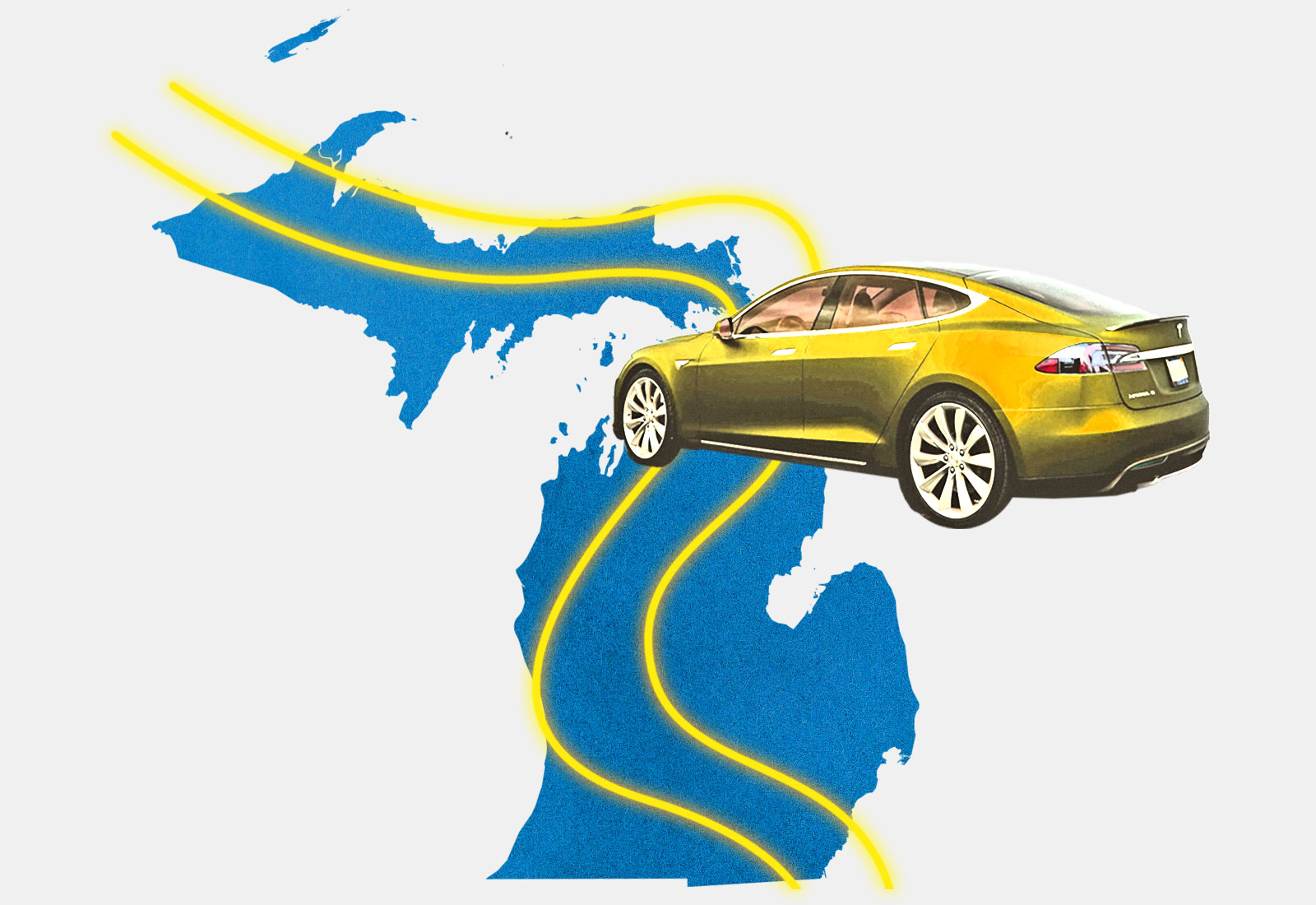To help Michigan reach its goal of carbon neutrality by 2050, Governor Gretchen Whitmer announced last month that the state will construct the nation’s first wireless electric vehicle charging road — a one-mile stretch in the Metro Detroit area.
“Michigan was home to the first mile of paved road, and now we’re paving the way for the roads of tomorrow,” Whitmer said in a press release, “with innovative infrastructure that will support the economy and the environment.”
A wireless EV road works like this: As a car drives over it, the vehicle’s battery is charged by pads or coils built under the surface of the street using magnetic induction. It doesn’t give the car a full charge, but it helps add some additional mileage to a vehicle before its next complete powering up.
The project is still in the very early stages: The Michigan Department of Transportation began accepting proposals for the project on September 28. Until one is selected, it’s unknown exactly where the road will be, what it will look like, the precise cost, or how soon it could be operational. But some are questioning whether the project is worth it. Is it the best use of funds in a state with poor transit and crumbling infrastructure? And how will it even work, particularly in a place with harsh weather extremes like the Midwest?
“It’s just not feasible or economically viable,” said Chris Mi, chair of the electrical and computer engineering department at San Diego State University who is an expert on electric vehicle charging. A one-mile demonstration is doable, he told Grist, but at the larger scale there are several practical and economic barriers.
Making new cars compatible with a wireless charging road tacks on thousands of dollars to the cost of a vehicle. “You have to build a receiver that is capable of receiving that kind of power,” Mi said, a price tag that could be high enough that no one would buy the car. Current electric vehicles would not be able to utilize the new road without purchasing an after-market receiver.
“We are encouraged by the state’s enthusiasm for electrification and look forward to continuing to work with the state as this project progresses,” Daniel Flores, a spokesperson for General Motors told Grist. “But it’s too early to comment on details that are still in development.”
Mi also estimated that a driver would gain just seven to 10 miles of charge from driving 60 miles per hour on the one-mile road, assuming a charge rate of 120 kilowatts per hour. It has yet to be decided, however, what rate the new Metro Detroit road will charge — it could be lower than the engineer’s estimate.
Weather is another major issue. “Michigan in the winter gets potholes all over the place, which means any of the wireless transmission systems you buried down in the road will be damaged in a couple of years,” Mi, told Grist, having researched wireless charging at the University of Michigan for several years.
According to the Michigan Department of Transportation, $1.9 million has been allocated for the new wireless charging road. A similar project built in Sweden in 2018, the world’s first, cost $2.4 million.
That’s a good chunk of money in a state that ranks 36 for transportation quality out of all U.S. states, according to an analysis by U.S. News. Some transportation advocates argue that it might make more sense to direct funds into improving Michigan’s current public transit systems instead. Using buses, light rail, and subways can result in a 30 percent reduction of carbon emissions for a two-person household. But, in Michigan, it’s hard to use the transit that already exists.
Until 2017, Detroit was the largest metropolis in the U.S. without surface rail transit. Since its completion a few years ago, the new system’s been wrought with issues, from extreme delays to slow speed to being shut down for much of the COVID-19 pandemic. Detroit’s bus system struggles too, and has gotten worse during COVID. Over the past year and a half, the city’s bus system has reduced routes and hours, increased regular wait times, had delays up to three hours, and in some cases the buses never come at all.
In Detroit, 92 percent of public transit riders are of color. For these riders, unreliable transit threatens their ability to keep jobs, attend appointments, get groceries, and pick up kids.
“It’s an equity issue,” said David Gifford, who created a guide to transit in Detroit and is on the board of Transportation Riders United, a local advocacy group. He told Grist that while Michigan subsidizes automakers and electric vehicle programs, it tells bus riders they have to pay for improved service themselves. “It’s very unfair, the way we fund our transportation,” he said.
Mi told Grist it would make more sense to build wireless charging stations at bus stops. The bus would stop for a few minutes, charge up, and go on its way. With such a system, the city’s buses would be cheaper too, because their batteries wouldn’t need to be as big. Or, Mi said, Michigan could try wireless roads at rest stops along the highway.
Todd Scott is a member of the Council on Climate Solutions for the State of Michigan, a group that advises Governor Whitmer on reducing greenhouse gas emissions and transitioning toward a carbon neutral economy. In the work he’s done with the Council, he told Grist he’s seen a “strong bias towards just producing more electric vehicles versus actually reducing carbon emissions.”
“There’s an unwillingness to even accept our responsibility for the situation that we’re in today,” he said. “It’s almost as if the climate crisis is seen as an economic opportunity for Michigan to make and sell more stuff, rather than a climate crisis that we need to deal with.”



